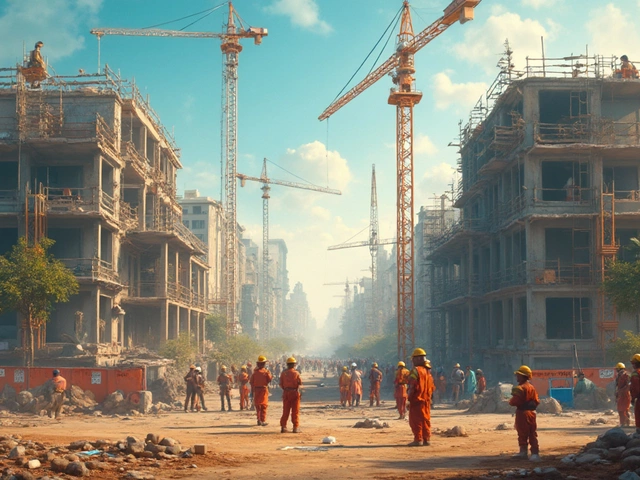Confused about what counts as a commercial building? You’re not the only one. People often blur the line between commercial, residential, and everything in between. Here’s the simple truth: commercial buildings are designed mainly for businesses to operate out of. If you see a place full of shops, offices, or restaurants—yep, that’s a commercial property.
But it’s not just about what goes on inside. Local rules decide if a building is commercial, so zoning laws have a big say in the matter. Land is split into categories for homes, businesses, or sometimes a blend. Build a coffee shop in a strictly residential area, and you’ll run into a mountain of trouble with the city.
- What Defines a Commercial Building?
- Types of Commercial Buildings
- Zoning and Regulations
- Common Features of Commercial Properties
- Why the Classification Matters
- Tips for Identifying Commercial Properties
What Defines a Commercial Building?
The easiest way to nail down a commercial building is to look at its main purpose. If the primary goal is to make money or support a business—think offices, retail spaces, or warehouses—it falls into the commercial camp. These buildings aren’t meant for living overnight, like a house or apartment. Sure, you might see an apartment above a store sometimes, but if most of the building is for a business, it gets that commercial label.
Zoning laws are another big deal. Cities split up areas into different zones: residential, industrial, and—yep—commercial. If you’re in a commercial zone, pretty much everything built there should follow business-friendly rules. Places like restaurants, stores, banks, and gyms are all examples of buildings set up for commercial activity.
Commercial buildings come in all shapes and sizes. Some might be a huge shopping mall, while others are just a single office tucked into a strip mall. The key isn't how big they are, but what people do there. Even a tiny corner coffee shop in a neighborhood counts if it’s set up mainly for business.
Here’s a snapshot to help you compare:
| Type | Main Purpose | Typical Uses |
|---|---|---|
| Commercial | Business activity | Shops, offices, banks, malls |
| Residential | Living space | Houses, condos, apartments |
| Industrial | Manufacturing, storage | Factories, warehouses |
Taxes and building requirements add to what separates commercial buildings. Local governments often charge higher property taxes on commercial spots, and the building codes are stricter too. Think extra rules for fire exits, accessibility for everyone, and strong plumbing to handle bigger crowds. So before you jump into anything, double check what the main use is and what the city says about the property. Saves you a lot of headaches down the road.
Types of Commercial Buildings
You might think every commercial building looks like a big glass office block, but there’s a ton of variety out there. These buildings come in different shapes and sizes. What matters is that they’re mainly used for work, business, or public activities—not as someone’s main home.
Here are some common types you see everywhere:
- Office Buildings: These usually house professional services—think accountants, law firms, marketing agencies. They can be downtown skyscrapers or small buildings in the suburbs. Some even allow a splash of retail on the ground floor (like a coffee shop or dry cleaner).
- Retail Properties: This group covers malls, strip centers, standalone stores, or even a local gas station. If there’s a place where someone sells stuff to people, it fits here.
- Industrial Buildings: These are set up for making things, storing goods, or shipping products. Warehouses, factories, and distribution centers are all in this bucket. Industrial properties sometimes take up massive footprints—fulfillment centers can reach hundreds of thousands of square feet.
- Hotels and Hospitality: From budget motels to five-star resorts, hotels count as commercial buildings because they exist for temporary stays and make money from guests.
- Multi-Family Apartments (Certain Kinds): Believe it or not, some apartment buildings count as commercial if they have five or more units. A duplex? Still residential. But a big complex? The bank, the city, and insurance all treat it as commercial property.
- Special Purpose Buildings: Hospitals, schools, sports arenas, movie theaters, and amusement parks land in this category. They don’t fit neatly into office, retail, or industrial—but they absolutely serve a business or public function.
What’s wild is how fast this world is changing. According to a 2024 industry report, warehouses and distribution centers grew their square footage by 18% over just two years, thanks to the rise of online shopping. Mixed-use buildings—think apartments above shops—are another trend, but their classification depends on how much space is dedicated to each use.
So, if you’re trying to size up a property or even pick an investment, pay close attention to which group it falls into. The rules, insurance, and even taxes change depending on the type of commercial building you’re looking at.
Zoning and Regulations
Zoning is basically the city’s way of controlling what happens on each chunk of land. A spot can be zoned for homes, businesses, factories—or a mix. For any commercial building project, zoning is step one. If your land is labeled as commercial on the city’s zoning map, you’re cleared for shops, office spaces, and a bunch of other business uses. Try using it for apartments, though, and you might get hit with legal headaches from day one.
Municipalities aren’t shy about their rules. You’ll see zoning codes like C-1 (local retail), C-2 (neighborhood shops with more services), or C-3 (big commercial hubs). Each level comes with its own set of dos and don’ts. For example, C-1 usually blocks things like auto repair shops or late-night bars, while C-3 lets in just about everything business-related.
Besides zoning, there are building regulations. Here are some things every commercial construction project has to face:
- Minimum parking spaces for customers and staff
- Handicap access—because ADA (Americans with Disabilities Act) isn’t optional
- Fire exits and sprinkler systems
- Height and size limits, set by local ordinances
- Signage rules—how big, how bright, and where you can slap your business logo
Here’s an example table showing common zoning categories and allowed uses:
| Zoning Code | Typical Uses |
|---|---|
| C-1 | Cafes, boutiques, small grocery stores |
| C-2 | Gyms, mid-sized retail, medical clinics |
| C-3 | Large shopping centers, auto dealerships, hotels |
Before you buy or build, always check the exact zoning code and talk to the building department. They don’t mess around, and getting the wrong permit can cost you big money or shut your project down. If you want to change how a property is zoned? That means filing for a zoning variance or applying for a rezone, which often involves public hearings and lots of paperwork. Don’t skip this homework—it isn’t optional in the world of commercial property.

Common Features of Commercial Properties
When you walk into a commercial building, a few things instantly give it away. First up—layout. Everything is super focused on business. Think open spaces for meeting rooms, reception desks, and separate sections for customers and staff. Unlike a house, you won’t find bedrooms, but you will find office cubicles, storefronts, service counters, or warehouse aisles.
Next, pay attention to safety. By law, commercial properties have features made to handle crowds or heavy equipment. You’ll usually spot wider hallways, ramps, elevators, and easy access exits for emergencies. Fire sprinklers, brighter lights, and security systems are a must. These aren’t just for show—they’re required by building codes and help businesses avoid costly lawsuits.
Parking matters, too. Commercial buildings are expected to offer parking lots or dedicated garages, sometimes dozens or even hundreds of spots, depending on the business type. Ever noticed how shopping plazas have endless rows of spaces? That’s for customers and delivery trucks coming in all day.
Let’s talk utilities and systems. Power loads in commercial spaces are way higher than what you’d find in homes. That's because restaurants, gyms, and shops need tons of electricity. You’ll also notice bigger HVAC units, robust plumbing, and maybe even backup generators. It’s not unusual for these buildings to be set up for things like internet cabling across multiple suites, loading docks for shipments, and industrial-sized waste disposal.
- ADA compliance: Always ramps, elevators, and accessible bathrooms.
- Signage: Spots for big, eye-catching signs and logos.
- Loading docks: Especially for warehouses or retail stores.
- Sprinkler systems: Legally required in most commercial spaces.
One stat worth remembering: The International Code Council says most commercial properties must have emergency exits every 200 feet in large buildings. That’s a lot, but it saves lives and keeps insurance costs down.
What finally ties everything together is zoning and use. A commercial property is set up for business use, has features to support high foot traffic, and meets strict local and national rules. If you notice these signs, you’re looking at a space built for commerce, not cozy living.
Why the Classification Matters
This whole business of calling something a commercial building is more than just labeling. It drives what you can legally do with the property, how you build and remodel, and even how much you pay in taxes. Here’s why it really matters:
First off, local governments have different rules for commercial construction compared to residential construction. For example, fire codes and access requirements are much stricter in commercial spaces since there’s a higher flow of people. You’re also looking at different rules for things like parking, signage, and even trash pickup. Ignore the rules, and you could face hefty fines or be told to shut down your business.
Next, the property taxes hit differently. In most cities, commercial properties get taxed at a higher rate than residential ones. That means if you’re planning to buy a building for your business, your yearly costs could be a lot higher than if you just bought a house.
| Property Type | Average Tax Rate (U.S.) |
|---|---|
| Commercial | 2.0% - 4.5% |
| Residential | 0.5% - 2.0% |
The type of building also affects your financing options. Banks look at tighter regulations and higher risks for businesses, so they might offer different (usually higher) interest rates and require a larger down payment for commercial building loans.
Let’s not forget insurance. A commercial property needs a policy that covers much more than your average homeowner’s plan. It needs to account for people coming and going, employees, even potential lawsuits if someone slips and falls inside your store.
- Zoning laws can stop you from using a residential spot for a business.
- Commercial codes push for better safety and accessibility features, like exit signs and wheelchair ramps.
- Renovation costs often spike since the work must follow tougher requirements.
If you try flying under the radar and use the wrong type of space, you risk losing your business license or getting tangled in legal issues that cost way more than doing things by the book. When in doubt, double check how your property is classified—this one detail changes everything about how you can use and improve it.
Tips for Identifying Commercial Properties
Sometimes, telling a commercial building apart from a regular house or apartment isn’t as obvious as you’d think. Here’s how you can quickly spot the differences and avoid mixing things up.
- Look at the activity: If you see shops, offices, clinics, gyms, or restaurants inside, you’re very likely dealing with a commercial property. Buildings buzzing with business usually don’t double up as someone’s main home.
- Check the zoning map: Every city or county handles zoning. You can look up the address online with your local planning department. If it’s marked as commercial or business, there’s your answer.
- Notice the signage: Big, visible signs for businesses, multiple business names on the front, or separate entrances for various companies? That’s textbook commercial. Residential buildings don’t usually advertise tenants this way.
- Parking lot size and setup: Large, dedicated parking lots or parking structures are telltale signs. Most apartments and homes don’t offer 50+ parking spaces or wheelchair-accessible business entrances.
- Building size and layout: Commercial buildings tend to have wider entrances, accessible ramps, bigger elevators, and open spaces that can be split up for various business tenants. Residential spots are usually smaller and more personal.
- Property tax rate: In most areas, commercial buildings are taxed at a higher rate than residential ones. If you check the property tax record and the rate is steeper than usual, you’re probably looking at a business property.
- Codes and permits: City records show what permits were pulled—look for commercial-use or business occupancy permits. That’s a rock-solid sign.
Here’s a quick comparison for major differences:
| Feature | Commercial Building | Residential Building |
|---|---|---|
| Primary Use | Business activities | Living space |
| Zoning | Commercial/Business | Residential |
| Tenants | Businesses, organizations | Individuals, families |
| Signage | Allowed and common | Limited or not allowed |
| Parking | Large lots, wheelchair accessible | Fewer spaces |
If you want to be 100% sure about a property, check with the local planning or building department. They’ll have the official answer on whether a spot is officially recognized as a commercial building. And if you’re eyeing a spot for your next business venture, knowing these signs can save you time—and money—before getting your hopes up.




Write a comment